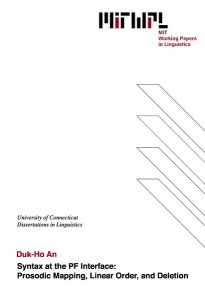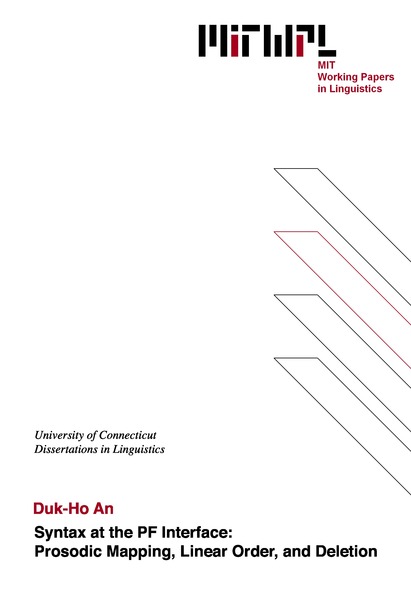Syntax at the PF Interface: Prosodic Mapping, Linear Order, and Deletion
D.-H. An, 2007
Table of Contents
Chapter 1 Introduction: On Interfaces (1)
Chapter 2 Prosodic Mapping at the Syntax-Prosody Interface
1. Introduction (9)
2. The Distribution of Null C Clauses (11)
3. Previous Approaches (14)
3.1. Stowell 1981 (14)
3.2. Webelhuth 1992 (17)
3.3. Pesetsky and Torrego 2001 (18)
3.4. Bošković and Lasnik 2003 (22)
4. Novel Generalizations and the Ban on Null Edge (24)
4.1. The Ban on Null SpecCP and C (26)
4.2. Obligatory Intonational Phrases (30)
4.2.1. Clausal Subjects (33)
4.2.2. Topicalization (36)
4.2.3. Noun Complement Clauses (38)
4.2.3.1. Restrictive Relative Clauses (41)
4.2.3.2. Verb Complement Clauses (44)
4.2.4. Extraposition, RNR, and Gapping (46)
4.3. Summary (48)
5. Proposal (50)
5.1. Some Assumptions about Prosodic Mapping (51)
5.2 Prosodic Mapping, Linearization, and the Ban on Null Edge (54)
5.2.1. Left and Right Boundaries (55)
5.2.2. Status of the Null C and Other Null Elements (60)
5.3. Other contexts (69)
5.3.1. Further Null C Contexts (70)
5.3.2. Extension to Non-CP Contexts (75)
6. Conclusion (80)
Chapter 3 Properties of Right Node Raising
1. Introduction (82)
2. Basic Properties of RNR (84)
2.1. Previous Approaches (84)
2.2. In-situ Property of RNR (87)
2.2.1. Island Insensitivity (88)
2.2.2. Preposition Stranding (90)
2.2.3. Complementizer Stranding (92)
2.2.4. Mobile Immobile Elements (93)
2.2.5. VP-Ellipsis (94)
2.2.6. Summary (96)
3. Previous Analysis: Multi-Dominance (97)
3.1. The Structure of MDW (97)
3.2. Linearization of MDW (99)
3.2.1. Linearization of MDW (99)
3.2.2. Right Edge Generalization (102)
3.3. Summary (105)
4. Some Problems for the MD Analysis (105)
4.1. Multiple Traces (107)
4.2. Multiple Binders (112)
4.3. Control (114)
4.4. Honorification (116)
4.4.1. Post-Syntactic Honorification? (123)
4.5. Linearization (127)
5. Summary (129)
Appendix: One Additional Problem for MDW (131)
Chapter 4 Non-syntactic Behavior of RNR
1. Introduction (135)
2. A Case for PF Deletion (137)
2.1. Insensitivity to Syntactic Constituency (138)
2.2. Target-internal Adjacency (149)
2.3. Peripherality (154)
2.4. Illustration: Incremental Linear Deletion (158)
3. Summary (165)
Chapter 5 RNR as PF Deletion
1. Introduction (167)
2. Deletion and Prosodic Constituency (169)
2.1. Sensitivity to Prosodic Constituency (171)
2.2. RNR Target as an I-phrase (177)
3. Direction of Deletion and Linear Order (187)
3.1. Background: Directionality Parameter (189)
3.2. Order Preservation: Fox and Pesetsky 2005 (191)
3.2.1. Holmbergs Generalization (192)
3.3. Deriving the Adjacency and the Edge Sensitivity of RNR (194)
3.3.1. Deriving Right Node Raising (196)
3.3.2. Deriving Target-internal Adjacency (198)
3.3.3. Deriving Peripherality (200)
4. Some Remarks on Prosodic Phrasing (202)
5. Summary (205)
Chapter 6 Extension of PF Deletion and Some Loose Ends
1. Introduction (207)
2. Linearization of ATB Structures (210)
3. Multiple Wh-Fronting and ATB (214)
3.1. Multiple Wh-Fronting and Lower Copy Pronunciation (215)
3.2. ATB Multiple Wh-Fronting (220)
3.3. PF Deletion and ATB Multiple Wh-Fronting (222)
4. Some Loose Ends (227)
4.1. Wide Scope of the Target of RNR (228)
4.2. Some Remaining Issues (233)
5. Summary (238)
Chapter 7 Conclusion (239)
References (241)
Abstract
The goal of this dissertation is to investigate the nature of the interaction between syntax and phonology with the goal of achieving an explanation of a number of facts that have remained problematic for purely syntactic approaches. More specifically, two main issues will be examined in this dissertation: the distribution of null complementizer clauses and Right Node Raising constructions. These issues are similar in that they both have been subject to purely syntactic analyses, which I show face serious problems. I will argue instead that these phenomena can be best analyzed in terms of the PF component. The gist of the analysis of the first issue will be that the distribution of null complementizer clauses is governed by the requirements of the syntax-phonology mapping process – in particular, the requirement that boundaries of an intonational phrase be properly aligned with those of the syntactic category to which it is assigned. With respect to the second issue, a PF deletion analysis will be argued for, providing several arguments that what is involved in Right Node Raising constructions is an operation of the PF component, not of the syntax proper. To support these proposals, several novel generalizations regarding the position and the prosodic property of the shared material will be proposed based on cross-linguistic evidence. In addition, implications of the current analysis for related constructions such as across-the-board movement constructions as well as the general architecture of the grammar and the syntax-phonology interface will also be discussed.

